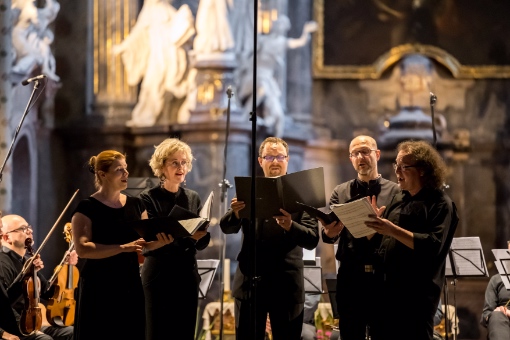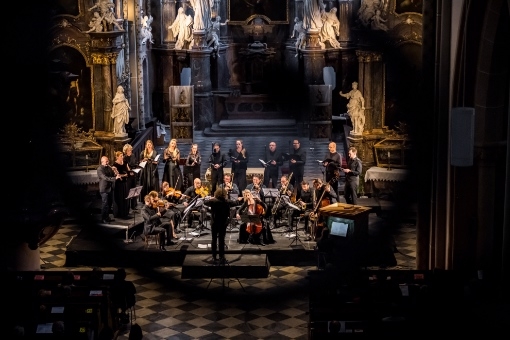The Concentus Moraviae International Music Festival has been underway in thirteen Moravian towns since the end of this May. The theme of the twenty-eighth edition, titled Between Kroměříž and Vienna, highlights the interconnectedness of the seat of the Olomouc archbishops and the Imperial Habsburg court. The concert held on Friday, 16 June in the reconstructed church of the Cistercian Abbey Porta Coeli, offered the audience a musical probe into the Moravian Baroque.
Conductor, musicologist and tenor Eduard Tomaštík and his ensemble Societas Incognitorum staged and performed the Missa Martialis by Pavel Josef Vejvanovský (1639-1693), written by the composer on the occasion of the Feast of the Annunciation (25 March) and completed in 1682. Its modern premiere was enriched by Gregorian choir chants, instrumental works and Czech sacred songs by Adam Václav Michna (1600-1676). Songs, whose lyrics pertained to the aforementioned feast, were replaced during the concert by sections of the mass proprium. The concert thus contained three levels of repertoire (and also interpretation), which intertwined with each other to form a coherent mass.
The evening opened with the song Archanjelské poselství (Archangel’s Message) representing the introitus. Tomaštík’s interpretation of the song displayed a certain looseness, which at times seemed to suggest a disparate musical sensibility among the musicians. The cantabile melody supported by expressive soprano voices contrasted with instrumental interludes of improvisational character, featuring for instance violinist Vojtěch Zajíc. The remaining two songs by Michna also flowed in this spirit. Archanjelské Ave (Archangel’s Ave) for an ensemble of singing voices accompanied by organist Marek Čermák gave the audience a rest after the sonically, dynamically and interpretively intense Gloria. Svaté lásky Labirynth (Holy Love Labyrinth) at the end of the concert mirrored a certain supplication, humility and longing related to Jesus Christ. The piece with the refrain verse “My love, O my Christ!”, which also functioned in instrumental form as a ritornello, culminated in the last verse a capella. The verses of the hymn thus moved towards the final silence, followed by the last chant of the Gregorian choir Ite missa est.

Missa Martialis for two clarinets, two violins, violas, trombones, five singers, choir and basso continuo is one of Vejvanovský’s later works. As is usual with the composer, he has demanding virtuoso parts, especially for the clarinet. Many parts of the mass ordinary (e.g. Kyrie, Hosanna in excelsis) represented Baroque contrapuntal notation, while others abounded with a powerful, colorful sound (Gloria) or a novel harmonic structure (e.g. Sanctus) filling the church space. The soloists also gave sovereign performances: Pavla Radostová (soprano), Kateřina Šujanová (soprano), Jan Mikušek (alto), Ondřej Múčka (tenor), Jiří Miroslav Procházka (bass). Both female singers demonstrated their skills not only in the solo parts but also in the duets (Credo, Sanctus). The same applies to the male singers, with Múčka demonstrating his singing versatility during his rendition of the Gregorian chants. Bassist Procházka impressed with the color of his voice, but in many sections the tutti faded away under the dynamic domination of the orchestra. The acoustics of the space itself, which the performers constantly had to work with, did not help the intelligibility and sound balance.
The audience were also able to savor true virtuosity in two instrumental works - Sonata B mollis (Vejvanovský) and Toccata cromatica con durezze e ligature (Kerll). The first of these is a composition for solo clarinet, zither, violas and basso continuo. The dialogue between the clarinet and the zither, a certain principle of echo, is based on modern playing (trumpeting) techniques of the time, which Vejvanovský mastered during his stay in Vienna. Even today, the work ranks among the most challenging pieces in the repertoire for trumpet, and in the context of an informed interpretation, the player must also demonstrate proficiency in the technical and interpretive issues of the period instrument. The soloists from the Societas Incognitorum ensemble gave us the opportunity to hear a good performance, at times encumbered by the trumpeter’s difficulties. The second aforementioned piece, as the title suggests, is based on the free treatment of voices and chromatic procedures hidden in the organ part, taken on by Marek Čermák. The work was included in the program between the Benedictus and Agnus Dei. Čermák’s staging substituted choral fantasies or improvisation in character, and again (as it did in other moments of the concert) fulfilled the function of color, composition and content contrast. In spite of my criticisms of the concert, it was a musical experience showcasing mass liturgy in the light of the diverse repertoire of leading Czech Baroque composers, which has been revived thanks to Eduard Tomaštík and his Societas Incognitorum ensemble.
Tereza Opálková
Program:
Pavel Josef Vejvanovský – Missa Martialis, Sonata B mollis
Adam Václav Michna - Archangel’s Message or The Annunciation of the Virgin Mary, Archangel’s Ave, Holy Love Labyrinth
Johann Jacob Kerll – Toccata cromatica con durezze e ligature
Chorale - Oratio, Ave Maria, Ite Missa est
Performers:
Societas Incognitorum
Pavla Radostova, Kateřina Šujanová - soprano
Jan Mikušek – alto
Ondřej Múčka - tenor
Jiří Miroslav Procházka – bass
Eduard Tomaštík - conductor
16 June 2023 at 7:30 pm, Porta Coeli Monastery
































No comment added yet..